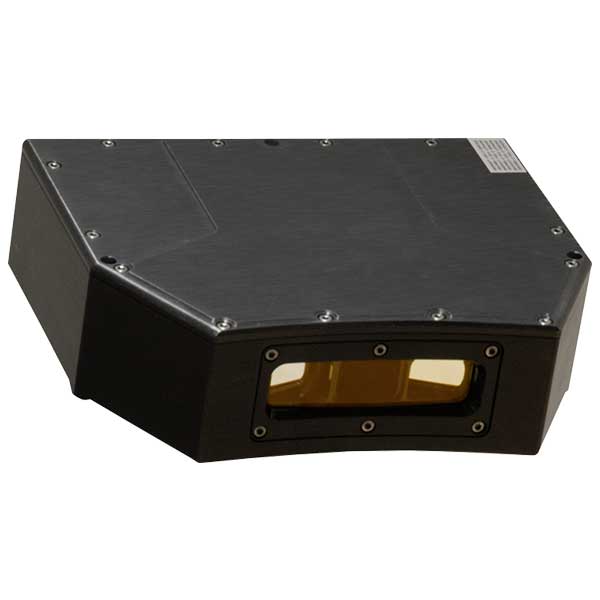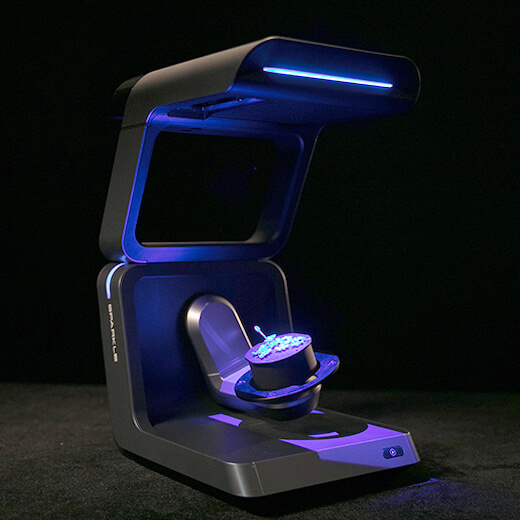Jewelry 3D scanners: Comprehensive guide and product selection

What is jewelry 3D scanning?
3D scanning is the process of digitally analyzing an object to obtain 3D information about its shape. A popular use of 3D scanning technology is jewelry 3D scanning.
This is the process of 3D scanning jewelry, precious metals, and gemstones with the goal of creating a digital copy of the original object. The digital copy can be used for many purposes, such as repairing or duplicating a valuable item.
3D scanners have been adopted as a supplementary tool by traditional jewelers, but the technology has also allowed newcomers to enter the field, many of which have combined 3D scanning with jewelry 3D printing.
This guide looks at some of the best jewelry 3D scanners on the market, in addition to discussing the various applications and benefits of 3D scanning jewelry.
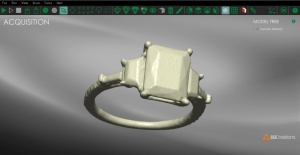
The best jewelry 3D scanners in 2023
| Brand | Product | Accuracy | Country | Price
Approximate starting prices based on supplier-provided information and public data. Prices may vary by region, over time and do not include additional products or services (taxes, shipping, accessories, training, installation, …).
| |
|---|---|---|---|---|---|
| Shining 3D
Product data validated by the manufacturer.
| AutoScan Sparkle | 0.01 mm | China | $ 14,000 | Quote |
| B9Creations
Product data validated by the manufacturer.
| B9 Scan 350 | 0.015 mm | United States | $ 15,000 | Quote |
| Polyga
Product data validated by the manufacturer.
| HDI Compact C506 | 0.012 mm | – | $ 16,990 | Quote |
| Medit | Solutionix D700 | 0.01 mm | South Korea | $ 25,000 | Quote |
| Artec 3D
Product data validated by the manufacturer.
| Micro | 0.01 mm | Luxembourg | $ 29,300 | Quote |
| Evatronix
Product data validated by the manufacturer.
| eviXscan FinePrecision | 0.006 mm | Poland | $ 35,000 | Quote |
The products in the table are ranked by price (low to high).

| Brand | Product | Accuracy | Max resolution | Country | Price
Approximate starting prices based on supplier-provided information and public data. Prices may vary by region, over time and do not include additional products or services (taxes, shipping, accessories, training, installation, …).
| |
|---|---|---|---|---|---|---|
| Shining 3D
Product data validated by the manufacturer.
| AutoScan Sparkle | 0.01 mm | 0.05 mm | China | $ 14,000 | Get a quote |
| B9Creations
Product data validated by the manufacturer.
| B9 Scan 350 | 0.015 mm | 0.052 mm | United States | $ 15,000 | Get a quote |
| Polyga
Product data validated by the manufacturer.
| HDI Compact C506 | 0.012 mm | 0.02 mm | – | $ 16,990 | Get a quote |
| Medit | Solutionix D700 | 0.01 mm | 0.01 mm | South Korea | $ 25,000 | Get a quote |
| Artec 3D
Product data validated by the manufacturer.
| Micro | 0.01 mm | 0.029 mm | Luxembourg | $ 29,300 | Get a quote |
| Evatronix
Product data validated by the manufacturer.
| eviXscan FinePrecision | 0.006 mm | 0.028 mm | Poland | $ 35,000 | Get a quote |
How jewelry 3D scanning works
Most jewelry 3D scanners are enclosed or partly enclosed desktop machines that offer ideal lighting conditions. Desktop jewelry 3D scanners almost always feature an automatic turntable, or auto-rotating table, on which the piece of jewelry is placed to be scanned.
Basic turntables only rotate at 360°, while more advanced, multi-axis turntable systems are able to tilt from side to side with multiple degrees of freedom. Hence, minimal manual input is required, and jewelers can 3D scan their objects at the click of a button.
In terms of technology, the majority of jewelry 3D scanners use structured light 3D scanning methods.
Structured light 3D scanners feature a light-emitting device (often a blue LED light) that projects a series of patterns onto the surface of the piece of jewelry. These patterns visibly deform according to the object’s surface and contours.
Meanwhile, a camera captures these deformed patterns, which are then processed by the scanner’s software to determine the jewelry’s precise geometry. The result is a 3D CAD model that can be modified, re-used, sliced for 3D printing, etc.
To recap, most jewelry 3D scanners feature the following characteristics:
- Desktop format with an enclosed or partly enclosed scanning area
- Automated thanks to a rotating table with one or multiple axes of movement
- Structured light technology with blue LED patterns
- High precision for complex details
Typical 3D jewelry scanning workflow
Put simply, a piece of jewelry is 3D scanned thanks to blue structured light technology. Then, the 3D scanner’s software creates a 3D model, which can then be exported to specialist CAD software suites for jewelers.
A typical workflow goes like this:
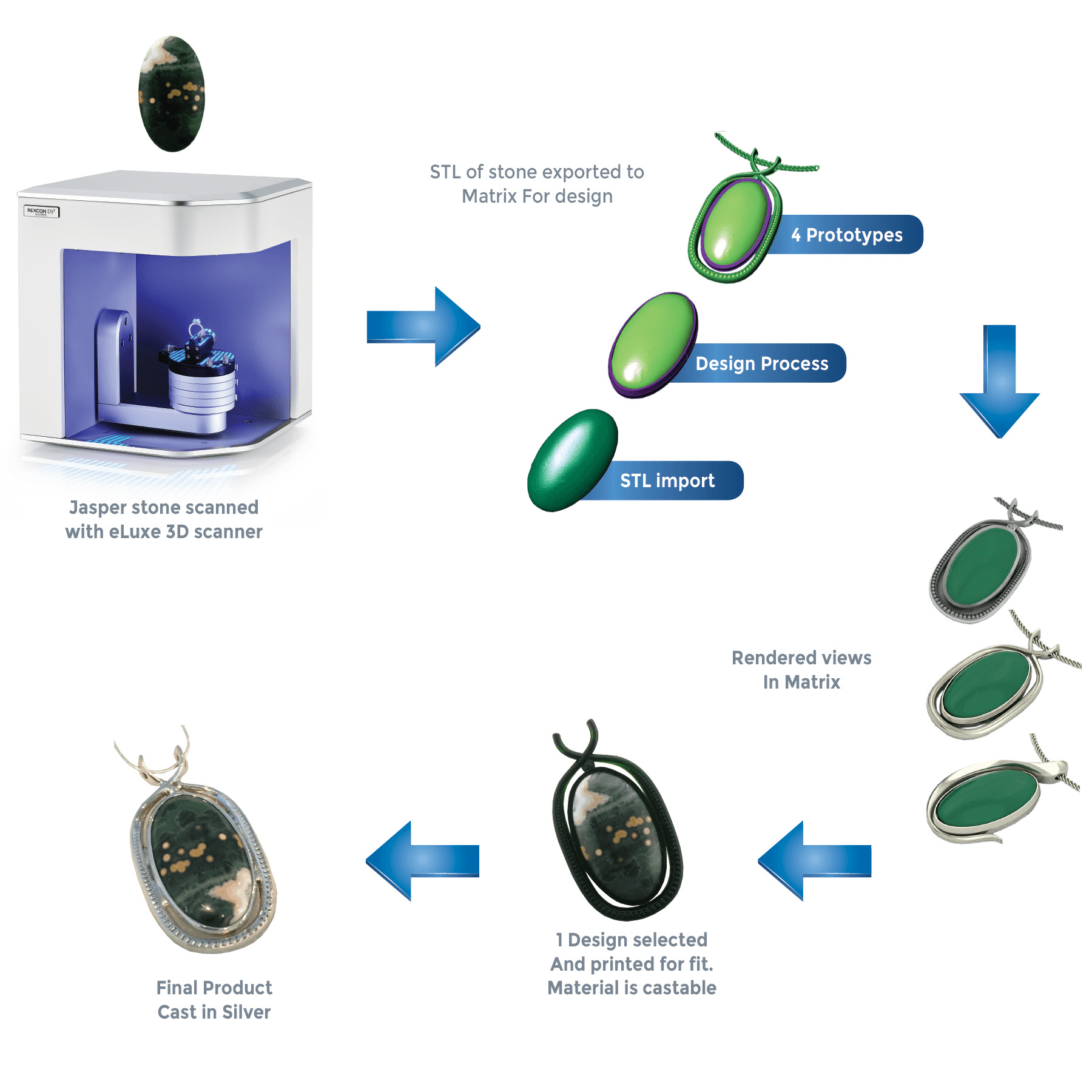
Here’s a deeper look into the major steps linked to 3D scanning jewelry.
1. Prepare jewelry
Left untreated, jewelry is difficult to scan, because a 3D scanner’s optical hardware has trouble processing shiny or reflective surfaces. Structured light patterns become distorted if reflected by the metal object.
This problem can be mitigated by spraying the jewelry with a temporary or washable matte coating (3D scanning spray).
2. Position jewelry
Most jewelry 3D scanners use an automatic rotating table (a.k.a. automatic turntable, multi-axis turntable), allowing the scanner to view the piece of jewelry from as many angles as possible.
The most detailed side of the piece should face upwards, where there is no physical contact with the turntable. In most cases, the user will have to flip the piece over in order for the scanner to capture the previously hidden surfaces.
3. Begin 3D scanning
Jewelry 3D scanners are packaged with 3D scanning software on which the user can launch 3D scans, operate the automatic turntable, and adjust scanning parameters (e.g. resolution).
Many of them enable one-click 3D scans and, thanks to auto-rotating tables, there is very little need for manual intervention.
4. Manipulate 3D model with CAD software
When a jewelry 3D scanner has completed scanning, its software creates a 3D mesh file (in STL file format, for example) of the piece of jewelry.
3D jewelry models are then commonly exported to a CAD software platform where the jeweler can edit or rework the piece, share it online, or simply store it digitally for future reference.
5. 3D print model
3D models obtained via jewelry 3D scanning can be 3D printed with the help of Stereolithography (SLA) 3D printing. SLA 3D printers are compatible with castable resins, which act as an alternative to wax in the direct investment casting process.
A jeweler can 3D print jewelry in castable resin, before surrounding the printed model with an investment material to make a mold. The 3D printed model is burnt out, leaving a cavity in the mold shaped like the original piece of jewelry.
Finally, the jeweler can pour molten metal — gold, silver, or bronze, for example — into the mold to create a new piece of jewelry.
In some cases, it can be possible to skip the casting process and print the piece of jewelry directly with a metal 3D printer.
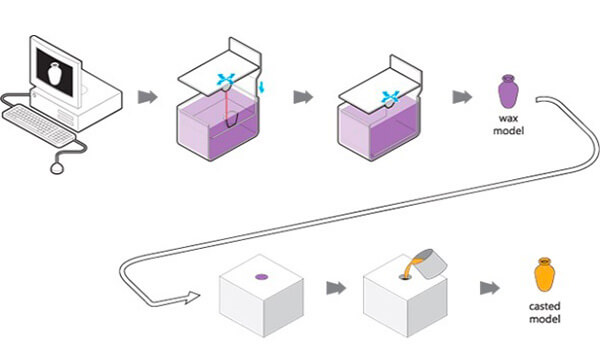
Overview of the best jewelry 3D scanners in 2023
Here we provide a deeper look into each jewelry 3D scanner from our list.
| Country | Luxembourg |
| Max resolution | 0.029 mm |
| Accuracy | 0.01 mm |
| Price | $ 29,300 |
Artec 3D, a Luxembourg-headquartered company with offices in Moscow and California, has been developing handheld and portable 3D scanners since 2007.
Their Artec Micro is an easy-to-use, high-precision desktop 3D scanner built for jewelry scanning, though it also has uses in dentistry and machine part scanning. A fully automated machine with one-click functionality, the Artec Micro scans with a point accuracy of up to 0.01 millimeters.
Artec’s versatile desktop 3D scanner scans items of jewelry using structured light technology: twin color cameras (6.4 megapixels) and a blue LED projector are complemented by a circular platform with a dual-axis swing-and-rotate system.
Real-time digital capture and previsualization is achieved using Artec’s dedicated software package, Artec Studio.
| Country | South Korea |
| Max resolution | 0.01 mm |
| Accuracy | 0.01 mm |
| Price | $ 25,000 |
South Korean 3D scanner manufacturer Medit has been in the business for two decades, providing solutions mainly destined for industrial and dental customers.
The Solutionix D700 is a fully automated desktop 3D scanner targeted at non-industrial users such as jewelry specialists who need to scan very small objects. The D700 is the most advanced 3D scanner in the Solutionix D-Series range of products, with a higher resolution than the D500.
The D700 scans items of jewelry with structured light technology that Solutionix calls “phase shifting optical triangulation.” This involves scanning from multiple angles to capture the entire profile of the object, then using those images to create a triangle mesh.
The D700’s two 6.4 megapixel cameras can capture details in full color.
| Country | United States |
| Max resolution | 0.052 mm |
| Accuracy | 0.02 mm |
| Price | $ 15,000 |
B9Creations is a 3D printing and 3D scanning company based in South Dakota. It has been creating 3D printers since 2011, and 3D scanners since 2018.
Designed specifically for the 3D scanning of jewelry and other small objects, the B9Creations B9 Scan 350 is an entry-level structured light scanner with 2-axis turntable rotation and an accuracy of 0.015 millimeters.
B9Creations states that the B9 Scan 350 can 3D scan any ring in less than five minutes. It achieves this using an LED projector with a brightness of 100 ANSI-lumens and a camera with a resolution of 1.3 megapixels.
| Country | Canada |
| Max resolution | 0.02 mm |
| Accuracy | 0.01 mm |
| Price | $ 16,990 |
Polyga HDI Compact C506 overview
The HDI Compact C506 is a 3D scanner produced by Polyga, a manufacturer based in Canada.
The HDI Compact C506 Polyga uses the structured light technology.
| Country | China |
| Max resolution | 0.05 mm |
| Accuracy | 0.01 mm |
| Price | $ 14,000 |
Shining 3D is part of the 3D scanning industry’s market leaders, producing 3D scanners (and 3D printers) since 2004. Their AutoScan series caters to a range of applications, with the AutoScan Inspec for metrology and the Sparkle version for jewelry.
This automated 3D scanner for jewelry features one of the largest scanning volumes of its category, and offers three degrees of freedom with its integrated turntable.
The AutoScan Sparkle comes with Shining 3D’s Ultrascan software for mesh exports but will require additional software for design purposes. Shining 3D namely lists Geomagic Design X, ZBrush, and Polyworks as suitable solutions.
| Country | Poland |
| Max resolution | 0.028 mm |
| Accuracy | 0.006 mm |
| Price | $ 35,000 |
Evatronix eviXscan FinePrecision overview
The eviXscan FinePrecision is a 3D scanner produced by Evatronix, a manufacturer based in Poland.
The eviXscan FinePrecision Evatronix uses the structured light technology.
Alternatives (other 3D jewelry scanners)
Here are a few other jewelry 3D scanning solutions from lesser-known manufacturers:
- Vylo Falcon3DX (South Korea)
- EGSolutions JScan 3 (Italy)
- eLUXE3D Gold 6.4 (United States)
3D jewelry software
After obtaining a 3D model from a 3D scan, jewelers may need to reverse engineer the mesh file into a new CAD format.
This is because mesh formats like STL interpret 3D models as an assortment of polygons, whereas actual pieces of jewelry tend to contain smooth, curved surfaces — not dozens of tiny triangles. CAD geometries like NURBS surfaces are better at representing these curves and are easier to edit.
The process of converting meshes into NURBS or subdivision surfaces is sometimes called retropology, and common tools for the practice include 3D Systems’ Geomagic X suite and the Mesh2Surface plugin for Rhino.
Once the scan has been converted, the jeweler can edit and rework the model.
Common CAD platforms used for jewelry design include 3Design, Rhino, and Matrix, while there are also a handful of jewelry-specific software suites such as Stuller’s MatrixGold and Gesswein’s JewelCAD, which provides features like automatic stone setting.
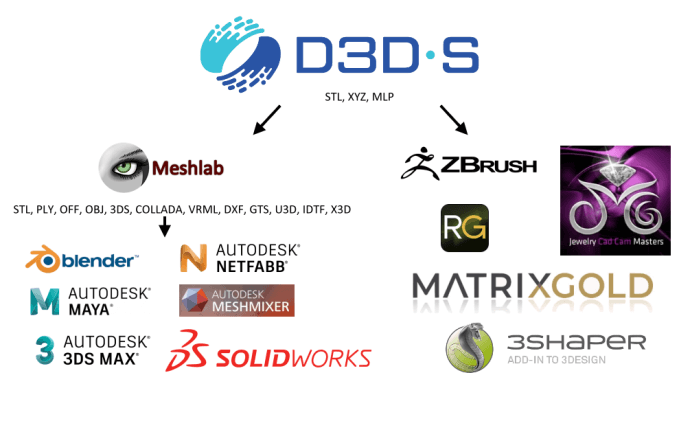
Key specifications for jewelry 3D scanners
There are several specifications to look into before purchasing a 3D scanning solution for metrology.
Knowing the important specifications of 3D scanning technology makes choosing the right jewelry 3D scanner much easier.
Terms you will frequently encounter include:
Scanning volume or field of view
The scanning volume of a 3D scanner is the size of the envelope in which it can detect the scanned object. The larger the volume, also called the field of view, the larger the objects it can scan.
Most jewelry 3D scanners have small scanning volumes.
Scanning resolution
Measured in millimeters or microns, the resolution is the smallest possible distance between two points of a 3D scan. It is also called point-to-point distance or points per scan. A smaller number, therefore, represents a higher resolution and a greater level of detail in the finished 3D model.
There are two different kinds of resolutions: measurement resolution and mesh resolution. Mesh resolution is the most important kind to consider, as it will be the resolution of your final 3D model. Manufacturers are sometimes unclear about which resolution they are referring to.
Camera resolution
The scan resolution is directly affected by the resolution of the scanner’s camera since the camera is what captures the light deformation.
Camera resolution is measured in megapixels, and a higher number of megapixels means higher resolution. 3D scanners often have dual cameras.
Accuracy
Accuracy is the degree to which the dimensions of the digital scan match those of the physical object. It is measured in millimeters or microns, with a lower number translating into better accuracy.
Speed
In 3D scanning, speed is the amount of time it takes to 3D scan an object. It can be measured in seconds per scan or in measurements per second (number of 3D points captured in one second).
However, the chosen resolution, object size, and other parameters affect scanning speed.
Degrees of freedom/movement
A 3D scanner’s number of degrees of freedom is the number of directions in which its scanning bed can move by rotating and tilting from one side to another.
More degrees of freedom allow the scanner to automatically capture the object from a greater number of angles, resulting in a more accurate and more complete scan. This also allows professionals to save time, requiring less manual manipulation.
Jewelry 3D scanner price
Jewelry 3D scanner prices start at around $8,000 and can go up to over $30,000 for the most advanced systems. Resolution, accuracy, amount of movement axes,, and other factors all contribute to the scanner’s pricing.
It is also important to keep in mind that 3D scanning software always requires powerful laptops in terms of RAM, graphics card, etc. If you are not well equipped, you may need to allocate several thousand dollars of your budget to a new PC.

Applications of jewelry 3D scanning
Jewelers use 3D scanners for many reasons. Some of the more common uses of jewelry 3D scanning include:
Heirloom reproduction
Using a 3D scanner, it is possible to create a 3D model of a valuable piece of jewelry, which can then be used to create a replica using 3D printing and casting techniques.
Customers may wish to create copies of a family heirloom to give to other family members, or so they can wear the duplicate while keeping the original safe.
Matching wedding bands
Many customers demand wedding bands that match the scale of their engagement ring. By 3D scanning the engagement ring, it is easy to create a matching wedding band using the digital model.
Stone setting
Jewelers often need to create new rings and settings for existing precious stones. By 3D scanning the gemstone, the jeweler can use the 3D model to create a setting that perfectly fits the stone.
Quality control
Even jewelers committed to traditional techniques may find 3D scanning useful as a tool for quality control. By scanning finished pieces, the jeweler can accurately measure overall dimensions and detailed features (a.k.a. metrology).
Reverse engineering and repairs
3D scanning jewelry allows jewelers to take an existing piece and build on the digital model in various ways. They may use the 3D model to create a new piece with modifications or to repair a damaged piece.
You may also like:
What is reverse engineering?
Archiving, concept showcasing, distribution
Once a jeweler has obtained a 3D scan of an item of jewelry, the digital file can be stored on a hard drive for safekeeping or uploaded to the internet.
Some modern jewelers sell their creations as digital files, allowing the customer to print the design themselves or through a 3D printing service.
Unique advantages of 3D jewelry scanning
3D scanning jewelry has benefits for both jewelers and customers when compared with traditional methods of jewelry creation, jewelry repair, and jewelry commerce.
- Speed: The speed that 3D scanning provides is vital for jewelers, who might otherwise spend many hours manually designing a piece to a similar level of detail.
- Accuracy: If a scanner is properly calibrated, it can reach a high level of accuracy. This is especially important with, for example, custom rings designed to fit the customer, or for perfect-fit gemstone settings.
- Permanent record: 3D scanning produces a permanent digital record of a piece of jewelry which can be revisited at any future point.
- Efficiency: Scanning is efficient because it only needs to take place once, even if thousands of duplicates will be made with the resulting digital file.
- 3D printing: 3D scanners can export files into a 3D printable format such as STL. Jewelers can use a 3D printed wax model to create a functional metal cast.
Current limitations of jewelry 3D scanning
Jewelry 3D scanning is still a new and developing process, and there are several areas where it could — and will — improve.
- Post processing: Even high-end 3D scanners produce partially incomplete models, and it is almost always necessary to fine-tune the resulting model (hole filling, smoothing, etc.)..
- Reflective surfaces: The shiny surfaces of metal objects reflect LED projections and lasers, confusing the data received by the scanner. Applying matte spray, which is the most common solution to this problem, is not always feasible with delicate or fragile pieces.
- Material recognition: A scanner cannot yet differentiate between metal and a precious stone. This means, for example, that a diamond ring is processed as one solid shape, not as one object (diamond) within another (ring).
- Formats: Exported file formats like OBJ and STL may present compatibility issues, since they are not easily editable like a CAD file.
- Conversion: Converting a mesh or point cloud into a 3D model is much more difficult than converting in the opposite direction.
FAQ
For professional-quality jewelry 3D scanning, you need a dedicated jewelry 3D scanner or a scanner designed to scan small objects.
Most dedicated jewelry 3D scanners are structured light scanners, which use high-resolution cameras and LED projectors.
Combining 3D scanning with 3D printing allows jewelers to create new pieces using the traditional investment casting process. 3D printing is not yet used to print the actual piece of jewelry, although there are a few exceptions (plastic pendants, for example).
Jewelers frequently use 3D scanning to create wedding bands that match an engagement ring in size and style. Wedding rings can also be saved as digital files or duplicated.
 English
English  Français
Français




